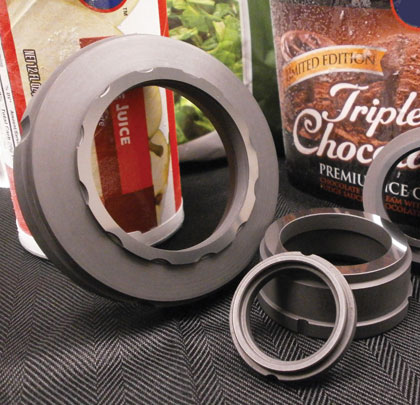Designing mechanical seals for sealing refrigerants and other low viscosity liquids has been a difficult problem for seal manufactures for many years. It has now been established that mechanical seals with antimony impregnated, carbon-graphite primary rings and solid silicon carbide counter face rings can solve this problem. Metallized Carbon Corporation, a global leader in the manufacture of oil-free, self-lubricating, carbon-graphite materials for severe service lubrication applications, announces the availability of mechanical seal primary rings for sealing refrigerants and other low viscosity liquids.
M-444: MORE THAN ORDINARY
Low viscosity liquids are difficult for mechanical seals because the hydrodynamic film that they create between the two rubbing seal faces is extremely thin. In order for this extremely thin hydrodynamic film to lubricate the two sealing faces, the seal faces must stay highly polished and they must run in very close proximity to each other. It is the self-polishing characteristic of the M-444, antimony impregnated, carbon-graphite material and the high dimensional stability of both solid silicon carbide and antimony impregnated carbon-graphite that enables these two materials to run in the required close proximity. Ordinary mechanical seals with resin impregnated, carbon-graphite primary rings do not have the self-polishing characteristic or the dimensional stability that is required for sealing these low viscosity liquids.
PASSING THE TEST
The table presents a list of typical physical characteristics of the M-444 mechanical seals. The following are definitions of terms and descriptions of methods used to obtain the physical characteristics. Physical characteristics of carbon/graphite materials are sensitive to part size, shape and grain direction. To obtain the data presented here, specimens were tested with the length dimension oriented parallel to the grain direction.
- Apparent Density (ANSI/ASTM C 559) is the mass per unit volume including permeable and impermeable voids and pores.
- Hardness (ANSI/NEMA CB1) is a material’s resistance to permanent deformation, particularly indentation or scratching. Shore Scleroscope hardness is determined by dropping a diamond pointed weight on a specimen from a standard height. The rebound up a graduated scale indicates hardness. Six readings taken on opposite sides of the specimen are averaged to obtain an accurate value.
- Compressive Strength (ANSI/ASTM C 695) is a material’s ability to withstand a uniaxial crushing load. Values are obtained from the ultimate crushing force per unit of cross section. Ultimate strength and yield strength are identical.
- Transverse Strength (ANSI/NEMA CB1) is a material’s ability to withstand a transverse or flexural load. Values are obtained by loading to failure a rectangular beam suspended on two knife edges.
- Tensile Strength (ASTM C 749) is a material’s ability to resist being pulled apart. Values are obtained from the uniaxial force at rupture per unit of cross section. Modulus of Elasticity (ASTM C 747) is a constant which expresses the ratio of stress per unit area to corresponding strain per unit length, the distortion or strain being within the elastic limit. Specimens are vibrated in the transverse mode, and values are calculated from the resonance frequency.
- Temperature Limit is the highest temperature that a material can tolerate without significant thermal decomposition or loss in strength; this varies with the amount of oxygen present. Metcar demonstrates an unusual ability to increase in strength with increase in temperature.
- Coefficient of Thermal Expansion (ASTM E 228) is the change in unit length per change in degree of temperature. Linear expansion is measured using a vitreous silica dilatometer which indicates dimensional changes of a specimen when subjected to heat.
- Thermal Conductivity is a material’s ability to transmit heat. Values are obtained from the cooling characteristics of a heated probe brought into contact with a specimen.
- Pressure Tight (a function of permeability) is a specification indicating the suitability of a given grade for use in seal ring applications. The internal cavity of a standard ring is pressurized with air. Its outside diameter is coated with a leak detecting fluid. An absence of bubbles (after two minutes at 100psi) defines acceptability.
BUILDING ON SUCCESS
Low viscosity liquids such as Freon refrigerants, liquid oxygen, liquid carbon dioxide, propane, ethylene, and acetone are now being successfully sealed using mechanical seals with Metcar Grade M-444, antimony impregnated, carbon-graphite primary seal rings. Since its inception in 1945, Metallized Carbon Corporation has been manufacturing high-quality, dependable bearing solutions for severe operating environments. With over fifty years of Application Engineering experience, Metallized Carbon offers the field expertise and data necessary to provide solutions for a wide variety of industries, supplying completely machined components as well as materials for customer machining.


